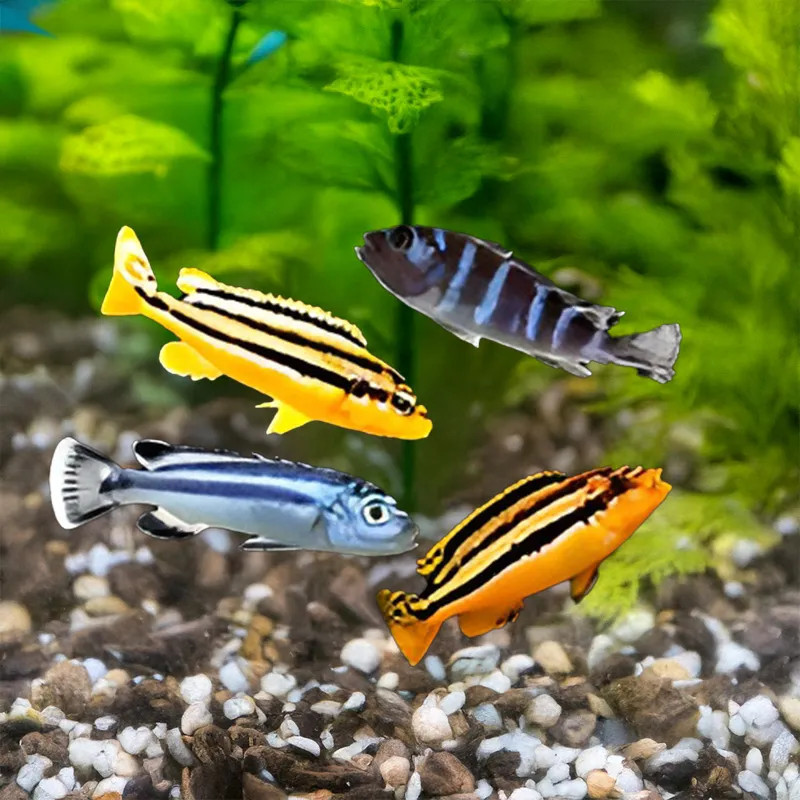Stocks Available
Flame Red Dwarf Agassizii
SKU:128914
APISTOGRAMMA AGASSIZII
1.75-2.25 INCH

Stock Available
Introduction: • Common Names: Mbuna Cichlids, African Mbuna • Natural Habitat: Native to the rocky shorelines of Lake Malawi in East Africa, where they inhabit rocky caves and crevices. Physical Characteristics: • Appearance: Generally small to medium-sized cichlids with elongated bodies and vibrant colors. Many species exhibit striking patterns and hues, including blues, yellows, and reds. • Size: Typically range from 3 to 6 inches (7.5 to 15 cm) in length, depending on the specific species. • Lifespan: Average lifespan is about 5-10 years in captivity with proper care. Habitat Requirements: • Tank Size: Minimum of 30 gallons for a small group; larger tanks are preferred for community setups to provide adequate territory. • Water Conditions: o Temperature: Ideal range is 75-80°F (24-27°C). o pH: Prefers alkaline conditions, ideally between 7.8 and 8.6. • Aquascaping: Provide plenty of hiding places and territories using rocks, caves, and stable structures, as they are territorial fish. Diet: • Primary Diet: Herbivorous; feeds on algae and plant matter in the wild, but also consumes small invertebrates. • Supplemental Feeding: Offer high-quality pellets formulated for African cichlids, along with occasional vegetable matter such as blanched spinach or spirulina. • Feeding Frequency: Feed small amounts 1-2 times daily, ensuring a balanced diet to maintain health. Compatibility: • Temperament: Generally aggressive and territorial, particularly during breeding and in smaller spaces. • Suitable Tank Mates: Best kept with other Mbuna species or similarly sized cichlids that can tolerate aggression; avoid small or timid fish. • Incompatibilities: Not suitable for peaceful community setups with small or slow-moving species, as they may be bullied. Care Level: • Difficulty: Moderate to challenging; requires stable water conditions and a well-planned aquarium setup. • Health Monitoring: Regularly check for signs of aggression, stress, and common cichlid diseases such as Malawi bloat. Breeding: • Breeding in Captivity: Successful with proper conditions; many species are mouthbrooders, where females incubate eggs in their mouths. • Spawning: Typically, females lay eggs in a safe area, and males fertilize them; the female then carries the eggs until they hatch. Economic Considerations: • Market Demand: Highly sought after due to their vibrant colors and variety of species available. • Wholesale/Retail Pricing: Prices vary based on species and coloration; generally affordable for most hobbyists. Sustainability and Conservation: • Wild Population: Some Mbuna species face threats from habitat loss and overfishing, while others remain stable. • Aquaculture Efforts: Increasingly bred in captivity to reduce pressure on wild populations and support sustainable practices. • Regulations: Compliance with local and international regulations is essential for responsible sourcing and trade. Conclusion: Mbuna Cichlids are a colorful and dynamic group of fish that bring life to African cichlid aquariums. Their unique behaviors, vibrant colors, and diverse species make them a popular choice among aquarists. With proper care, a well-planned aquarium, and suitable tank mates, Mbuna can thrive, adding beauty and excitement to any aquarium setup.
Data sheet
16 other products in the same category:
Customers who bought this product also bought: